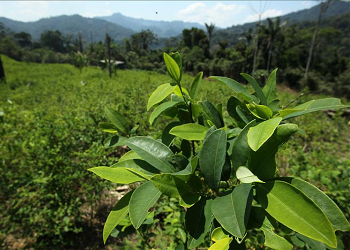New information on coca crops by Peru’s top drug officials suggest that cultivations may be growing for the first time since 2011, and that cocaine production is becoming more efficient.
Carmen Masías, president of Peru’s anti-drug agency DEVIDA, has stated that Peru currently has an estimated 55,000 hectares of coca crops, mainly for cocaine production. This figure is higher than the latest UN estimates that there were 40,300 hectares in the country in 2015. It is also slightly above the US government’s 2015 estimate, which has been higher than the UN statistic for the past two years.
Masías explained in a recent interview with EFE news agency that the higher figures were the result of a modified, more “sophisticated” methodology that Peru had worked on “with the participation of the United Nations.”
“We have come closer to a much more accurate figure,” Masías added.
SEE ALSO: Coverage of Coca
Masías noted that the new methodology includes registers of cultivations that are less than one year old. Peruvian officials have previously told InSight Crime that the satellites used by the United Nations to predict coca levels cannot detect crops younger than nine months.
According to UN estimates, Peru’s coca cultivations have been decreasing steadily since 2011. US data shows more of an upward trend, with its 53,000 hectares estimate for 2015 representing the highest figure since 2008, except for a peak in 2013. The Peruvian government’s data is used to support the United Nations’ research, which is published in an annual report.
The new count given by Masías will provide the baseline figure for Peru’s 2017 to 2021 anti-narcotics strategy.
InSight Crime Analysis
Peru’s higher coca count could well be down to a greater ability to detect cultivations, but there are also indications that the country’s coca and cocaine production may increasing again.
DEVIDA Technical Director Vladimiro Guzmán told InSight Crime that new plots of coca are appearing in the country, notably in border regions and rainforest areas such as Putumayo province, adjacent to Colombia. He explained that a “bubble effect” is occurring, by which the eradication of coca fields in one area has led to expansion and cultivation in new areas, often through deforestation.
This adds to the existing plots that, once eradicated by authorities, are re-cultivated by farmers, Guzmán added. This is one of the main obstacles for anti-narcotics efforts, and over the past two years over 90 percent of intervened areas are thought to have been re-planted.
Another worry is that criminal groups are looking to optimize cocaine production.
“They’re trying to improve the productivity of [coca crops] with new technology, the use of chemical precursors, etcetera,” DEVIDA’s technical director said.
SEE ALSO: Coverage of Cocaine Production
Guzmán suggested that Peruvian producers may be learning from Colombian organizations. While Peruvian coca has typically yielded higher amounts of drugs than that in Colombia due to the greater maturity of the bush, over the past 10 years innovative techniques have boosted Colombian cocaine yield threefold in certain areas.
It is possible that government intelligence has been catching up to the reality of coca production at the same time that farmers are breaking in to new areas. But if Peru’s coca has indeed begin to rise again, this promises to exacerbate global anti-narcotics efforts even further, with authorities already struggling to grapple with soaring cocaine production in neighboring Colombia.

